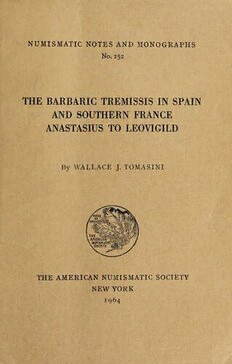Table Of ContentTHE AMERICAN NUMISMATIC SOCIETY
Founded. 1858 • Incorporated 1865
Broadway Between 155TH& 156TH Streets
New York, N.Y., 10032
PURPOSES: The Society was founded for the collection and preser
vation of coins, medals, decorations and paper money and for the
investigation of their history and other subjects connected therewith.
MEMBERSHIP: Applications for membership are welcomed from
all interested in numismatics. Inquiries regarding membership
should be addressed to the Secretary of the Society.
DUES: The annual dues for an Associate Membership are $10.00.
Issues of the Notes and Monographs, Museum Notes, Hispanic
Numismatic Series, and Numismatic Literature arc distributed to all
members.
PUBLICATIONS: The Numismatic Notes and Monographs consist
of separately issued publications, each on a single topic, of which
usually several appear each year. The American Numismatic
Society Museum Notes is a publication, irregular in appearance,
consisting of brief notes and papers, principally on items in the
Society’s collections. Numismatic Literature is a quarterly listing
current numismatic publications with abstracts of their content.
Numismatic Studies is a series accommodating works in a larger
format. The Hispanic Numismatic Series, published in cooperation
with the Hispanic Society of America, consists of publications
devoted to the coinage of the Iberian Peninsula, and is based on
the collections of the Hispanic Society.
MUSEUM: The Society maintains a museum located in uptown
Manhattan, New York City, which houses its offices, collections
and library. Collections embrace coins of all periods from their in
ception to modem times, medals and decorations. Selections from
its cabinets are on display in an exhibition. The library, consisting
of about 20,000 volumes, covers all branches of numismatics.
The museum is open to Members and the public on Tuesdays,
Wednesdays, Thursdays, Fridays and Saturdays. It is closed on
Sundays and Mondays and the following holidays: New Year’s
Day, Lincoln’s Birthday, Washington's Birthday, Memorial Day,
Independence Day, Election Day, Thanksgiving Day and Christ
mas Day. The hours of the Library are from 9 a.m. to 5 p.m. The
public exhibition is open from 10 a.m. to 5 p.m.
NUMISMATIC NOTES AND MONOGRAPHS
Number 152
The Barbaric Tremissis in Spain
and Southern France
Anastasius to Leovigild
By WALLACE J. TOMASINI
THE AMERICAN NUMISMATIC SOCIETY
NEW YORK
I964
ALL RIGHTS RESERVED BY
THE AMERICAN NUMISMATIC SOCIETY
PRINTED IN GERMANY
AT J. J. AUGUSTIN • GLÜCKSTADT
TO
WALTER W. S. COOK,
who introduced me to the Visigoths and to Numismatics,
AND
RICHARD OFFNER,
who taught me how to see.
CONTENTS
FOREWORD ...................................................................................................... ix
BIBLIOGRAPHY, COLLECTIONS AND KEY TO ABBREVIATIONS . . . . XÜi
I. ANTECEDENTS FOR THE SIXTH CENTURY TREMISSIS . . . . I
II. THE SIGNIFICANCE OF THE VPW TYPE AND ITS USE ON THE
ANASTASIUS TREMISSIS IN THE WEST ...................................... 12
III. BARBARIANS AND THE VPW TREMISSIS ......................................... 25
IV. THE DATING OF THE TREMISSIS
A. THE DATE OF THE FIRST VPW ANASTASIUS TREMISSIS . . 45
B. THE DATE OF THE LAST VPW ISSUE ...................................... 63
V. DETERMINANTS FOR STYLISTIC ANALYSIS ............................. 76
VI. THE ANALYSIS OF GROUPS ......................................................... 88
VII. OBSERVATIONS ON STYLE GROUPS AND PROGRESSIONS . . . . I35
STYLISTIC FACTORS OF DESIGN........................................................I35
LEGENDS..................................................................................................I43
STARS AND CROSSES.............................................................................I45
WEIGHTS..................................................................................................148
MINT ATTRIBUTIONS.............................................................................152
CONCLUSION : VISIGOTHIC ART AND NUMISMATICS ........................173
THE CORPUS ..........................................................................................................183
CHARTS
GENERAL ABBREVIATION KEY TO CHARTS .........................................2ÓI
I. TREMISSES IN THE VTH CENTURY ...............................................2Ö2
II. TREMISSES AND l\ SCRIPULUM IN THE LATE IVTH CENTURY 264
III. VPW IN OTHER DENOMINATIONS IN GOLD AND SILVER, LATE
IVTH—VTH CENTURIES ......................................................................266
IV. VPW IN BRONZE, LATE IVTH-VTH CENTURIES ...........................268
VÜ
viii Table of Contents
V. LEGEND ASSOCIATION WITH VPW TYPES IN Æ3 AND Æ4
ISSUES ..................................................................................................271
VI. INCIDENCE OF VPW TYPES IN GOLD,S ILVER AND BRONZE . . 275
VII. NUMBERS OF COINS STUDIED BY STYLE GROUPS AND BY
COLLECTION...................................................................................283
VIII. STYLE GROUP PROGRESSIONS.....................................................288
IX. QUANTITATIVE GRAPH OF FRENCH AND IBERIAN COLLECTIONS
STUDIED..........................................................................................289
X. FREQUENCY TABLE OF WEIGHTS OF COINS IN MAJOR GROUPS 29O
Xa. GRAPH OF CHART X — AVERAGE WEIGHT IN LARGEST
WEIGHT GROUP.............................................................................292
Xb. GRAPH OF CHART X — AVERAGE WEIGHT OF ALL SPECI
MENS OF KNOWN WEIGHT .....................................................293
XC-Xi. AVERAGE WEIGHTS IN STYLE GROUP PROGRESSIONS 294
XI. FREQUENCY TABLE OF WEIGHTS OF COINS IN COMBINED
MAJOR AND SUB-GROUPS ...............................................................296
Xia. GRAPH OF CHART XI — AVERAGE WEIGHT IN LARGEST
WEIGHT GROUP............................................................................298
Xlb. GRAPH OF CHART XI — AVERAGE WEIGHT OF ALL SPECI
MENS OF KNOWN WEIGHT .....................................................299
INDEX TO LETTERED PLATES ......................................................................3OO
PLATES .................................................................................................................303

